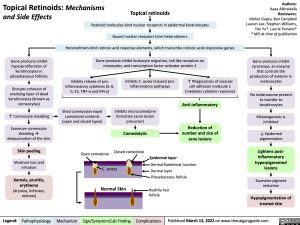Topical Retinoids: Mechanisms and Side Effects
Topical retinoids
Authors: Ayaa Alkhaleefa Reviewers: Mehul Gupta, Ben Campbell Lauren Lee, Stephen Williams, Yan Yu*, Laurie Parsons* * MD at time of publication
Gene products inhibit tyrosinase, an enzyme that controls the production of melanin in melanocytes
No melanosome present to transfer to keratinocytes
Melanogenesis is inhibited
↓ Epidermal pigmentation
Lightens post-
inflammatory hyperpigmented lesions
Excessive pigment reduction
Hypopigmentation of treated skin
Gene products inhibit hyperproliferation of keratinocytes in pilosebaceous follicles
Disrupts cohesion of overlying layer of dead keratinocytes (known as corneocytes)
↑ Corneocyte shedding
Excessive corneocyte sheddingà desquamation of the skin
Skin peeling
Moisture loss and irritation
Xerosis, pruritis, erythema (dryness, itchiness, redness)
Retinoid molecules bind nuclear receptors in epidermal keratinocytes
Bound nuclear receptors form heterodimers
Heterodimers bind retinoic acid response elements, which transcribe retinoic acid-responsive genes
Gene products inhibit leukocyte migration, toll-like receptors on monocytes, and transcription factor activator protein-1
Inhibits release of pro- inflammatory cytokines (IL-6, IL-12, TNF-α and IFN-γ)
Shed corneocytes expel comedonal contents (open and closed types)
Open comedone
Inhibits C. acnes induced pro- inflammatory pathways
Inhibits microcomedone formation (acne lesion precursor)
↑ Phagocytosis of vascular cell adhesion molecule 1 (mediates cytokine response)
Anti-inflammatory
Reduction of number and size of acne lesions
Comedolytic
Closed comedone
Epidermal layer
C. acnes
Normal Skin
Dermal-Epidermal Junction Dermal layer Pilosebaceous follicle
Healthy hair follicle
Legend:
Pathophysiology
Mechanism
Sign/Symptom/Lab Finding
Complications
Published March 13, 2022 on www.thecalgaryguide.com
Foundations
Systems
Other Languages
Dermatology Comedones Topical Retinoids: Mechanisms and Side Effects topical-retinoids-mechanisms-and-side-effects

